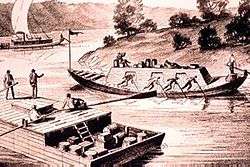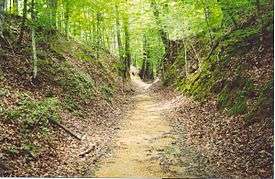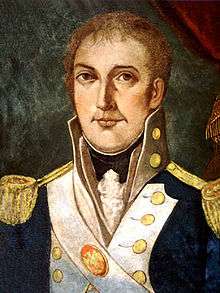Peter Alston
| Peter Alston | |
|---|---|
 While, with his father, the notorious counterfeiter, Philip Alston, at the infamous, outlaw lair of Cave-in-Rock, Peter Alston, around 1797-1799, joined Samuel Mason and his gang of river pirates, on the Ohio River. | |
| Born |
after 1765 ? |
| Died |
February 8, 1804 Old Greenville, Jefferson County, Mississippi Territory, present-day Greenville, Jefferson County, Mississippi |
| Cause of death | execution by hanging |
| Resting place | unknown |
| Nationality | American |
| Other names | James May, Samuel May, Isaac May |
| Occupation | river pirate, horse thief, burglar, highwayman, counterfeiter |
| Known for | Being the criminal associate of serial-killer, Wiley "Little" Harpe and his partner, in the murder of notorious outlaw gang leader, Samuel Mason. Alston was also, the son of the American 1770s counterfeiter, Philip Alston, who had connections to Cave-in-Rock, Russellville, Kentucky, and Natchez, Mississippi. |
| Parent(s) | Philip Alston, Temperance Smith, Mary Molly Temple, Mildred McCoy |
| Relatives | Solomon Alston (grandfather), Sarah Ann "Nancy" Hinton Alston (grandmother) |
Peter Alston (after 1765 - February 8, 1804) was the late 18th Century and early 19th Century counterfeiter, horse thief, highwayman, and river pirate, who was believed to be the associate of serial-killer, Little Harpe and partner, in the murder of notorious outlaw, leader Samuel Mason in 1803. Alston was also, the son of the colonial-era counterfeiter, Philip Alston, associated with Cave-in-Rock, Illinois, and Natchez, Mississippi.[1]
Early life
Peter Alston was born the son of the notorious counterfeiter. His mother was one of the three wives of his father: Temperance Smith, Mary Molly Temple, or Mildred McCoy. Alston had two brothers, Philip, Jr. and John McCoy and two sisters, Frances and Elizabeth Elise. His grandparents on the side of his father were Solomon Alston and Sarah Ann "Nancy" Hinton Alston. John Alston, the brother of his father, was also, a notorious counterfeiter. The Alston family had its origins in the British Royal colony of the Province of South Carolina, where the Alston surname was very common. When and where he was born and where he grew up is not known, as there is scant information on his childhood and pre-criminal activities. He may have been born in South Carolina, North Carolina, Virginia, Natchez, West Florida, now Natchez, Mississippi, Fort Nashborough, Virginia, now Nashville, Tennessee, or Russellville, Virginia, now Russellville, Kentucky. Having been the son of an outlaw, Peter Alston probably moved wherever his father hastily moved their family, remaining as far away from the pursuit of the law. Even as an adult, No doubt, Peter Alson was not far from his father's criminal presence and influence.
Criminal activities
According to Alex C. Finley, in The History of Russellville and Logan County, Ky, Peter Alston used the alias "James May", as Wiley Little Harpe had used the name "John Setton", as his alias. At other times, Alston also, used the aliases, Samuel May and Isaac May.[2]
The earliest recorded use of the Peter Alston alias, James May, dated back to around 1797 or 1798, in Red Banks, Kentucky, now Henderson, Henderson County, Kentucky, where Alston appeared, with a woman, who claimed to be his lame sister, which could have been, one of his two sisters, Francis or Elizabeth. While at the Red Banks, Alston stole horses, but was caught in Vincennes, Northwest territory, now Vincennes, Indiana, and brought back for trial. Peter Alson was never tried, as he broke out of jail the first night he was incarcerated.[3]
Peter Alston later shifted his operations down river to Stack Island, on the lower Mississippi River, along with Samuel Mason, the notorious outlaw gang leader, after regulators cleaned the frontier criminal element out of western Kentucky and Cave-in-Rock, Northwest territory, now Cave-in-Rock, Illinois, in the summer of 1799. There Alston reunited with his father, Philip, and cast counterfeit silver coins, as well as taking part in Mason's river piracy operations.[4]
Arrest and execution
Mason was captured in 1803, and was transported overland from New Orleans towards the Mississippi Territory for trial. He escaped en route, sustaining a gunshot wound in the process, and may have made his way back to his former gang. Mississippi territoreial Governor William C. C. Claiborne posted a $2,200 reward for Mason's recapture, which Alston and Harpe attempted to claim under the assumed names of "James May" and "John Setton." In so doing they presented Mason's severed head as proof that he was no longer at large. Their true identities were quickly discovered and both men were arrested for Mason's murder. Convicted and sentenced to death on February 4, 1804, they were hanged four days later. Their own heads were cut off and placed on poles, along the Natchez Trace.[5]
Gallery
 While on the Ohio River and later the Mississippi, Peter Alston joined Samuel Mason and his gang of river pirates, chose flatboats, keelboats, and rafts, as profitable targets, to attack, because of the valuable and plentiful cargo on board.
While on the Ohio River and later the Mississippi, Peter Alston joined Samuel Mason and his gang of river pirates, chose flatboats, keelboats, and rafts, as profitable targets, to attack, because of the valuable and plentiful cargo on board.- Peter Alston along with Wiley "Little" Harpe were captured with the Samuel Mason Gang, in 1803, and brought before the Spanish Territorial commandant, Colonel Robert McCoy, in New Madrid, Spanish Upper Louisiana Territory, New Spain The courtroom would have been a small, simple, structure similar to the Old Cahokia Courthouse, in Cahokia, Illinois Country, Northwest Territory.
- When Peter Alston, Wiley "Little" Harpe, and the Samuel Mason Gang, received their hearing, in the Spanish colonial court, of New Madrid, the frontier courtroom may not have been much bigger, than a typical courtroom interior, as was found in the Old Cahokia Courthouse.
 The old path of the "Natchez Trace", where, between 1799 and 1803, Peter Alston, Wiley "Little" Harpe, and the Samuel Mason Gang committed highway robbery and murder, against helpless and unsuspecting travelers.
The old path of the "Natchez Trace", where, between 1799 and 1803, Peter Alston, Wiley "Little" Harpe, and the Samuel Mason Gang committed highway robbery and murder, against helpless and unsuspecting travelers. In 1803, Mississippi Territorial governor, William C. C. Claiborne, offered a $2,000 reward, a very large sum of money, at the time, for the capture or severed head of Samuel Mason. Peter Alston and Wiley "Little" Harpe brought in the head of Mason to collect the reward and were identified and hanged.
In 1803, Mississippi Territorial governor, William C. C. Claiborne, offered a $2,000 reward, a very large sum of money, at the time, for the capture or severed head of Samuel Mason. Peter Alston and Wiley "Little" Harpe brought in the head of Mason to collect the reward and were identified and hanged.
References
- ↑ T. Marshall Smith. 1855. Legends of the War of Independence, and of the Earlier Settlements in the West. Louisville, Ky.: J. F. Brennan, Publisher. 342-344. Online at www.archive.org.
- ↑ Alex C. Finley. 1876, Reprint c. 2000. The History of Russellville and Logan County, Ky. Reprint: Russellville, Ky.: A. B. Willhite. 42 (number from reprint).
- ↑ Otto A. Rothert. 1922, reprint 1996. The Outlaws of Cave-in-Rock. Carbondale, Ill.: Southern Illinois University. 171.
- ↑ Smith 343.
- ↑ Rothert 260-261.
Further reading
- Asbury, Herbert. The French Quarter: The Informal of the New Orleans Underworld
- Magee, M. Juliette. Cavern of crime. Livingston Ledger, 1973.
- Rothert, Otto A. The Outlaws of Cave-In-Rock. Cleveland: 1924; rpt. 1996 ISBN 0-8093-2034-7
- Smith, Carter F. Gangs and the Military: Gangsters, Bikers, and Terrorists with Military Training. Lanham, MD: Rowman & Littlefield, 2017.
- Wagner, Mark J. The Wreck of the '"America" in Southern Illinois: A Flatboat on the Ohio River. Carbondale, IL: Southern Illinois University Press, 2015.
- Wagner, Mark and Mary McCorvie. "Going to See the Varmint: Piracy in Myth and Reality on the Ohio and Mississippi Rivers, 1785–1830," X Marks the Spot: The Archaeology of Piracy. Gainesville, FL: University Press of Florida, 2006.
- Wellman, Paul I. Spawn of evil: the invisible empire of soulless men which for a generation held the Nation in a spell of terror. New York: Doubleday, 1964.
